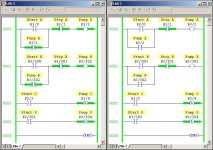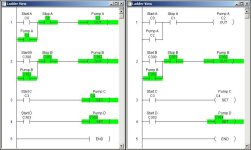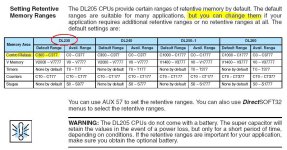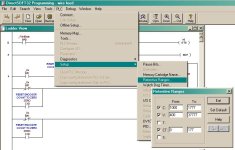Ron Beaufort
Lifetime Supporting Member
Greetings to all,
for those who aren’t totally tired of the “latch or don’t latch” discussion in this recent thread, here is one more little item that may interest those of you who work with Direct Logic PLCs from Automation Direct ... the next several posts discuss the very basic ideas behind the “retentive memory ranges” for those systems ...
first of all ... a preview of where we’re going with this ... we’ve already discussed (in that earlier post) that with an Allen-Bradley system, if we want a particular output to “come-back-up-in-the-ON-condition” after a processor power cycle, then we would normally use a “latch-on” arrangement rather than a “seal-in” construction ... so the question now becomes: “suppose that I’m using a Direct Logic system and I need the same functionality?” ... well, Direct Logic processors don’t have “latches” and “unlatches” like the Allen-Bradley processors ... so ... with a Direct Logic system, the simple answer is to use the “SET” instruction to turn the output ON ... and to use a “RESET” instruction to turn the output OFF ... so is that all there is to it? ... stay tuned ... you might be unpleasantly surprised ...
WARNING! ... the following material may not be suitable for young programmers ... parental discretion is advised! ...
next - just so that we can compare apples to apples – here is a simple “before and after” screen shot of an Allen-Bradley program ... the basic idea is that we have two simple “seal-in” type rungs and two simple “latch-on” type rungs ... in the “before” condition on the left, the control bits for all four “Pumps” have been turned ON by their respective rungs ... as we’ve discussed in tedious detail throughout the previous thread, with an Allen-Bradley system, the “latched-on” rungs are “retentive” ... the “sealed-in” rungs are NOT “retentive” ... specifically, after a processor power cycle, the “latched-on” rungs WILL come back up in the “run” condition ... the “sealed-in” rungs will NOT come back up in the “run” condition ...
[attachment]
and ... as shown in the “after” screen shot on the right ... there are no real surprises here ... sure enough, after a processor power cycle, the “latched-on” rungs DID come back up in the “run” condition ... the “sealed-in” rungs did NOT come back up in the “run” condition ...
so now the stage is set ... on to the Direct Logic system in the next post ...

for those who aren’t totally tired of the “latch or don’t latch” discussion in this recent thread, here is one more little item that may interest those of you who work with Direct Logic PLCs from Automation Direct ... the next several posts discuss the very basic ideas behind the “retentive memory ranges” for those systems ...
first of all ... a preview of where we’re going with this ... we’ve already discussed (in that earlier post) that with an Allen-Bradley system, if we want a particular output to “come-back-up-in-the-ON-condition” after a processor power cycle, then we would normally use a “latch-on” arrangement rather than a “seal-in” construction ... so the question now becomes: “suppose that I’m using a Direct Logic system and I need the same functionality?” ... well, Direct Logic processors don’t have “latches” and “unlatches” like the Allen-Bradley processors ... so ... with a Direct Logic system, the simple answer is to use the “SET” instruction to turn the output ON ... and to use a “RESET” instruction to turn the output OFF ... so is that all there is to it? ... stay tuned ... you might be unpleasantly surprised ...
WARNING! ... the following material may not be suitable for young programmers ... parental discretion is advised! ...
next - just so that we can compare apples to apples – here is a simple “before and after” screen shot of an Allen-Bradley program ... the basic idea is that we have two simple “seal-in” type rungs and two simple “latch-on” type rungs ... in the “before” condition on the left, the control bits for all four “Pumps” have been turned ON by their respective rungs ... as we’ve discussed in tedious detail throughout the previous thread, with an Allen-Bradley system, the “latched-on” rungs are “retentive” ... the “sealed-in” rungs are NOT “retentive” ... specifically, after a processor power cycle, the “latched-on” rungs WILL come back up in the “run” condition ... the “sealed-in” rungs will NOT come back up in the “run” condition ...
[attachment]
and ... as shown in the “after” screen shot on the right ... there are no real surprises here ... sure enough, after a processor power cycle, the “latched-on” rungs DID come back up in the “run” condition ... the “sealed-in” rungs did NOT come back up in the “run” condition ...
so now the stage is set ... on to the Direct Logic system in the next post ...








